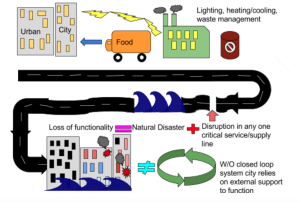1.Question 1 (In 250 words): Are dense anthropocentric developments as resilient/adaptive to major change as their counterparts?
Simply put, for a variety of reasons with the most influential being economical, urban metropolises aren’t as adaptive to major “change” as ecosystems are. Especially in this modern age with a sprawling human population, the effects of this deficiency become all the more pronounced when disasters do happen. Many times when such events occur a state of emergency is declared (not trying to debate the merits of such a declaration) and external aide is quickly provided. City plans are designed on the premise that all if not a majority of the needs or services a city requires will be delivered to it rather than addressed “in house.” This type of perspective means that little if any thought goes into adequately designing space to maximize the various utilities a space may have to offer(whether vertical, on the ground, etc…). Vital services include waste management, energy generation, efficient heating/cooling biomimicry among others that can be tackled in many ways depending on the topography throughout the city. For example, a city’s skyline is usually dominated by the all too familiar block-like skyscrapers that during a heat wave can’t alleviate the increased heat efficiently without added strain on the power lines. The aggregate demand of such a scenario in addition to any unforeseen natural disasters could lead to serious issues. While most skyscrapers are constructed in a manner that minimizes costs, the city collectively would benefit from skyscrapers that mimic biology in design and function. (Such arrangements= increased weight savings, less materials needed, more sunlight exposure, better deflection of heat, etc…) Lastly, a cities’ reliance on external support means it’s prone to abrupt disruptions more so than an ecosystem because an ecosystem’s biodiversity allows for a greater carrying capacity and resiliency(=greater margin of error).
2.Question 2 (In 150 words): What can cities do to lessen the affects of major disasters/changes.
Cities can encourage developers to emphasize the services local ecosystems can provide to both the structure and it’s residents. An example could be vegetation on vertical surfaces to provide adequate water absorption, cooling, air filtration, aesthetic and physiological appeal as well. Depending on the topography, the city would best be served to have a biomass plant on high ground as a defense against flooding (if a biomass plant were to get flooded the “mass” could cause outbreaks in the surrounding area due to low hygiene treatment). Encourage local production to meet the cities’ food consumption demand (counties would have to work together to collectively create policies that benefit both) as well as having “farm space” vertically perhaps. Gradually reconfiguring street traffic for pedestrian, bicyclists and motorists use would greatly help in decongesting traffic and maximizing flow. Public parks could be multi storied to take advantage of “air space” over the conventional park on the ground surface. Also include more community-orientated places for leisure.


Hey Gershom, it’s Rob Hudert. Link: http://sites.psu.edu/geog30/2016/04/17/biodiversity-robert-hudert/
I like the focus of your diagram, which shows both issues hurting biodiversity and ways to solve problems that hinder biodiversity. I am not from PA, but do attend PSU in State College and happen to find stink bugs every so often in my house. I was not aware that they were an invasive species nor that they do not have any predators.